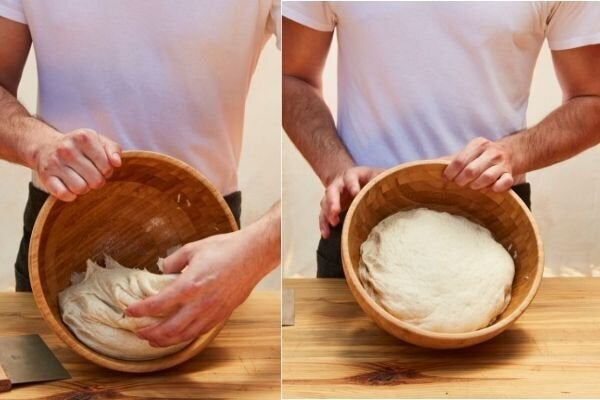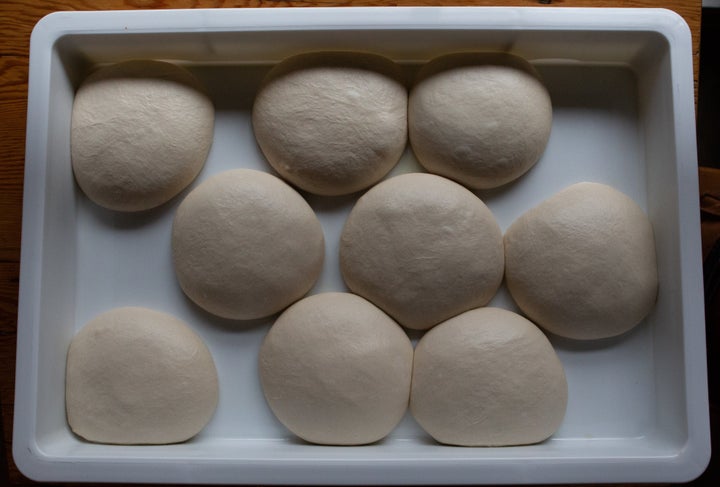When it comes to making pizza, there’s a key ingredient absolutely essential to success that may surprise you, no matter which recipe you use: time. Specifically, rise time.
As pizza dough rises, the yeast consumes the sugars in the flour and turns them into CO₂ and alcohol, both of which lend airiness and flavor to the pizza crust after it’s been baked. But some people let their pizza rise two hours, while others wait longer than 24 hours. Who’s right?
The passion for pizza-making is real, so not all chefs will agree. But we managed to find a group of industry experts who agreed on one common fundamental truth.
Rest pizza dough in the fridge for at least a day.
All of the experts interviewed for this article agreed that a cold fermentation is best for producing a flavorful pizza dough that’s airy and easy to digest, and that at least 24 hours is best.
Matthew Hyland, chef and co-founder of Emily and Emmy Squared restaurants in New York, explained that the refrigerator offers a “consistent environment that does not fluctuate to a great degree. It takes longer, but the structure of the dough develops better over a longer period of time.”
Jonathan Davis, senior vice president of culinary innovation at Los Angeles-based La Brea Bakery, likes to let his pizza dough rise for 24 hours to allow for flavor development and a better interior structure.

“The temperature during fermentation is what ultimately determines the complexity of the flavor and texture outcome of the dough,” Davis told HuffPost. “If the dough is fermented at a cooler temperature, the flavor will be similar to that of a complex sourdough, depending on what type of pre-ferment or yeast you are using, whereas a dough fermented at a warmer temperature might have a one-dimensional flavor profile, which isn’t usually desirable. In regards to the dough’s interior structure, having it at a cooler temperature during fermentation reduces the number of bubbles that escape from the dough, improving the overall texture with open crumb structure and good elasticity.”
Don’t let it rise for too long, though.
Though a long and slow rise is beneficial for flavor and texture, you can run into issues if you allow your pizza dough to rest for too long. Michael Schwartz, James Beard award-winning chef, founder of Genuine Hospitality Group and author of “Genuine Pizza: Better Pizza at Home,” told HuffPost that his ideal fermentation window is 24 to 48 hours, and he warned against letting pizza dough proof (the final stage of the rise) in the refrigerator for too long.
“A few days’ rise is fine and will enhance the taste of the crust, but any more than three days and the yeast will start to eat up all the sugar in the dough and convert it into alcohol, which will adversely affect crust flavor,” Schwartz said.
Over-proofing is another consequence of resting your dough for too long. Hillary Sterling, executive chef and partner at Vic’s in New York City, told HuffPost that the dough used at her restaurant ferments for 24 hours –– any longer and the dough over-proofs, falls flat and can have a denser crust. When dough is over-proofed, the gluten over-relaxes and the internal structure of the dough is compromised, resulting in a collapsed final product.
Here’s how to speed it up if you don’t have 24 hours.
Though fermentation time is important, it’s not impossible to make great pizza in one day. Proofing the dough at room temperature will speed up the process.
“Ideally, you’d make the dough the day before baking and let it slowly rise in your refrigerator, but sometimes planning ahead can be tricky, so making the dough in the morning to use that evening is OK as well,” Schwartz said.
Ken Forkish, owner of Ken’s Artisan Pizza and Checkerboard Pizza in Portland, Oregon, and author of “The Elements of Pizza” and “Flour Water Salt Yeast,” has a same-day dough recipe (called the Saturday Pizza Dough) that ferments at room temperature for eight hours, “but my room temperature and yours may be different,” Forkish told HuffPost.
You’ll know your dough is ready to be stretched and baked when it has doubled in size, according to Master Instructor Leo Spizzirri, co-founder of the North American Pizza and Culinary Academy in Chicago. If you’re using the cold fermentation method, you need to let the dough rest outside of the refrigerator and come to room temperature ― about one to two hours, depending on the temperature of your kitchen.
“We never want to stretch a cold dough!” Sterling said. “After the dough comes to room temperature, it will start to rise again to form a slightly larger smooth dome. As soon as you pick it up, it will allow you to stretch it with ease and the gluten will not resist. When the dough is ready to bake, you should be able to poke a hole in it and the dough will hold the shape of your finger.”
Pre-portion your dough and cover it before putting it in the fridge.
If you made enough dough for multiple pizzas, it’s important to divide and shape the dough before resting it. “Since pizza dough is a living, breathing thing, it’s necessary to make the dough, then portion and shape it into individual balls before placing each one in an individual air-tight container and refrigerating for at least 24 hours,” Spizzirri told HuffPost.

Spizzirri always weighs his dough in order to have consistent results, as bake time and temperature will vary depending on size. “Once we divide the balls into our desired weight, we roll each portion into a tight dough ball,” Spizzirri said. “This tight ball gives resistance during the maturing process in the refrigerator and controls the rate at which the dough ball opens.” The airtight containers prevent the dough from forming a skin, which can cause tears in the dough when stretching it, as well as breakage when the pizza is transferred into the oven or while it’s baking.
Dividing the dough and rolling it into balls also helps with shaping the dough when it’s time to stretch it. Forkish recommended shaping the dough balls after a couple of hours of primary fermentation, before allowing the dough to sit overnight in the refrigerator.
“Each dough ball will expand from the fermentation gases (CO₂ and ethanol), and as it does, the dough ball will become less tight and more relaxed,” Forkish said. “If you divide up segments of dough for each pizza from the main dough and just let them sit, unformed, you could still make pizza but not as easily. It needs the strength and cohesiveness that happens as a result of it being made up into a ball.”
You can use dry yeast or go the extra mile with a pre-ferment or starter.
The experts interviewed for this article had a wide range of recommendations for the type of yeast used to make pizza, so feel free to use what is best or most convenient for you.
Spizzirri, for example, likes to use instant dry yeast. “It’s easier to work with because it’s not as volatile as fresh yeast,” he said. “The shelf life for dry yeast is about two years, so long as it’s kept sealed in the refrigerator. I also like instant yeast because it can be added into the dough with your dry ingredients and no special attention is needed as you would with active dry yeast, where it needs to be activated in 110 degree Fahrenheit water before being added to the dough.”
Tony Gemignani, 13-time World Pizza Champion, uses a pre-ferment starter when making pizza dough at home. “For the best dough, starters work great; they can be made using yeast or made naturally,” Gemignani told HuffPost. “Not every home cook has the time to do this, but I urge people to attempt it because the results are amazing. Using a pre-ferment starter versus a straight yeast typically gets you a better structure, and flavor, and it’s more aromatic.”